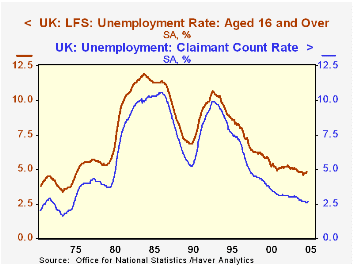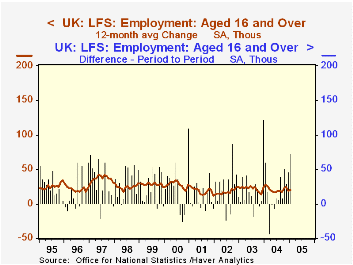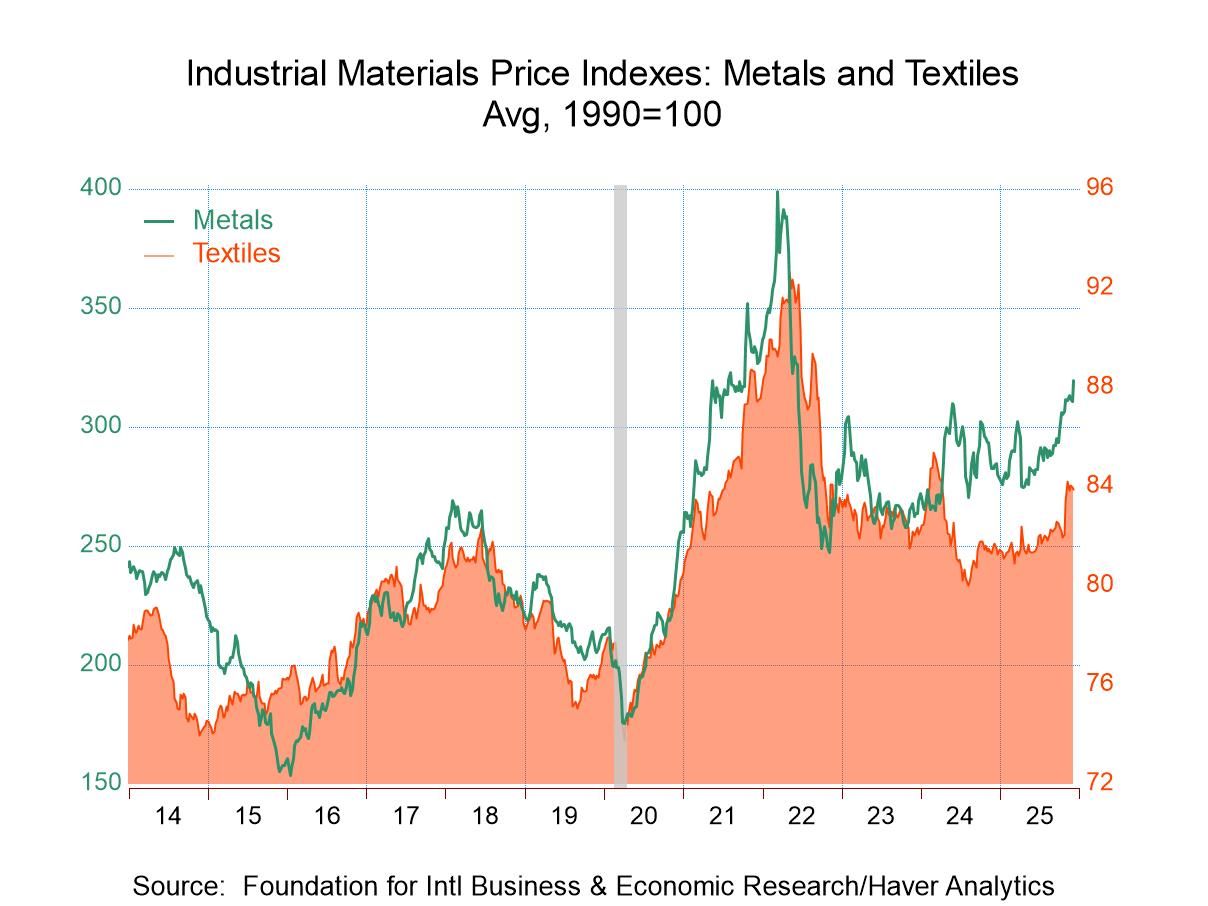 Global| Apr 13 2005
Global| Apr 13 2005UK Unemployment Ticks Up in February, But Employment Also Shows Strong Rise
Summary
Press reports on today's UK labor force data highlight the increase in unemployment measures. The ILO-defined concept, similar to that in the US, rose in the three months to February by 0.1% to 4.8%. The so-called "claimant count" [...]

Press reports on today's UK labor force data highlight the increase in unemployment measures. The ILO-defined concept, similar to that in the US, rose in the three months to February by 0.1% to 4.8%. The so-called "claimant count" increased 11,000 in March, with the associated rate rising to 2.7% from 2.6% in February. Wire service headlines and story leads pointed out that this was the largest monthly increase in claimants since May 2003, and noted that it was unfortunate coincidence that the news came on the very day the Prime Minister and the Labour Party begin their quest for reelection next month.
There are offsetting factors, though, that remove some of the sting from these unemployment figures. Firstly, both unemployment rates even at their new, slightly increased levels, remain the second lowest in nearly 30 years. Except for three recent months at 2.6%, the claimant count rate has not been as low as 2.7% since May 1975. The broader ILO unemployment rate was at or above 4.8% from September 1975 through last June; since then, the low was just 4.6% in August. So these latest figures hardly indicate a significant upturn, let alone a major uptrend in unemployment. (The ILO definition represents a three-month moving average centered on January.)
Moreover, employment rose once again and by a larger amount than in the previous several reports. The labor force measure, the number of people saying they have jobs, rose 72,000 to 28.64 million, still another a new high. This too is a 3-month centered moving average for January, compared to the December figure.
The average earnings index (AEI) for February (a 3-month moving average ending in February) was up 4.7% on a year ago, compared with 4.4% in the previous couple of reports. However, the acceleration was due to bonus payments, as the underlying base earnings measure eased to 4.3% from 4.4%.
| United Kingdom Seasonally adjusted data |
Mar 2005 | Feb 2005 | Jan 2005 | Dec 2004 | 2004 | 2003 | 2002 |
|---|---|---|---|---|---|---|---|
| Unemployment Rate (%) | 4.8* | 4.7* | 4.7 | 5.0 | 5.2 | ||
| Claimant Count (thous) | 829 | 818 | 814 | 824 | 854 | 933 | 947 |
| Employment (mil) | 28.64* | 28.57* | 28.44 | 28.18 | 27.91 | ||
| Change (thous) | +72K | +46K | +0.9% | +0.9% | +0.8% | ||
| Average Earnings Index Incl Bonuses: "Headline Rate"(%)** | 4.7 | 4.4 | 4.4 | 4.4 | 3.4 | 3.5 | |
| Average Earnings Index Ex Bonuses: "Headline Rate" (%)** | 4.3 | 4.4 | 4.4 | 4.2 | 3.6 | 4.0 |
Carol Stone, CBE
AuthorMore in Author Profile »Carol Stone, CBE came to Haver Analytics in 2003 following more than 35 years as a financial market economist at major Wall Street financial institutions, most especially Merrill Lynch and Nomura Securities. She had broad experience in analysis and forecasting of flow-of-funds accounts, the federal budget and Federal Reserve operations. At Nomura Securities, among other duties, she developed various indicator forecasting tools and edited a daily global publication produced in London and New York for readers in Tokyo. At Haver Analytics, Carol was a member of the Research Department, aiding database managers with research and documentation efforts, as well as posting commentary on select economic reports. In addition, she conducted Ways-of-the-World, a blog on economic issues for an Episcopal-Church-affiliated website, The Geranium Farm. During her career, Carol served as an officer of the Money Marketeers and the Downtown Economists Club. She had a PhD from NYU's Stern School of Business. She lived in Brooklyn, New York, and had a weekend home on Long Island.





